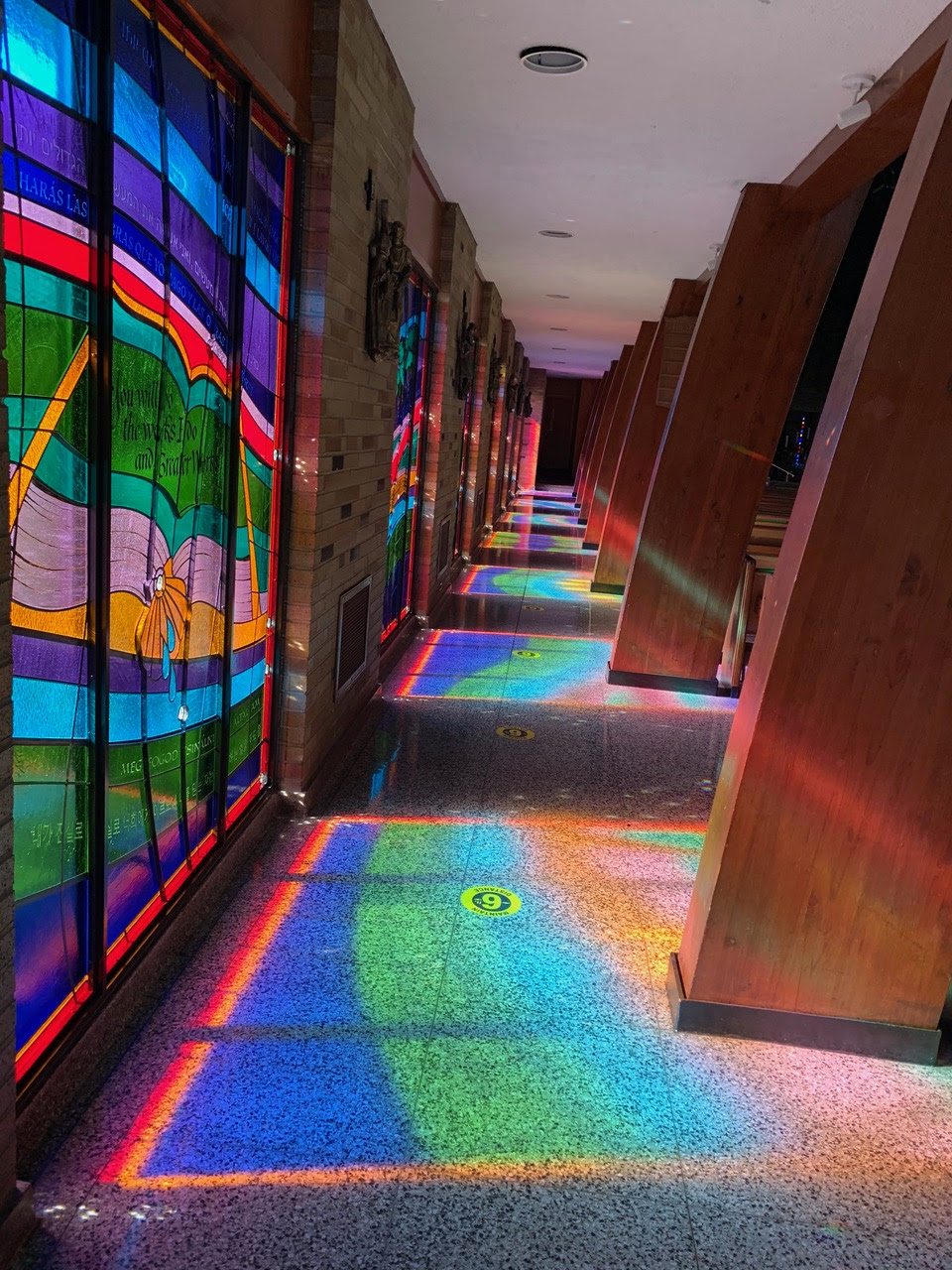A Brief History of the Creation of the Windows
Shortly before our parish fire in 2018 we began the process of designing Stained Glass Windows as a celebration of our 75th Jubilee Year. Most of the money for the commissioning of the windows was through the donation of a family who wishes to remain anonymous. A Liturgical Design Committee was formed comprised of parishioners, our Liturgical Architect James Hundt and the stained-glass artists of Butler/Vargo Artglass Inc., Indianapolis, Indiana. A year-long design process included education about Art Glass, symbolism in art, the use of color and contrast, prayer and reflection, a study of the history of our parish and some very lively discussions. In February 2019, the clergy visited the artist’s studio in Indiana to review, in person, the color choices for the glass and to observe the process of creating the window panels. Production of the windows and their installation was delayed due to the worldwide health crisis of 2020. The Windows were installed in April 2021.
The Schematic Design
The windows tell our story as disciples of Christ and as the people of God at St. Philip the Apostle Parish. The clockwise window journey begins on the parking lot side near the piano and concludes on the Valley Road side near the Blessed Mother statue. Our story as disciples begins with the East windows (parking lot side). These windows depict the call to discipleship found in the Scriptural encounters that our patron St. Philip had with Jesus. Biblical characters are represented in the design of these windows.
Jesus told Saint Philip, “You will do the works I do and greater works.” The mission to continue Christ’s work is our mission as a church community therefore, the West windows, (Valley Road side) tell the story of our parish. Our journey of faith is represented as we engage with the Scriptures and Sacraments. The unique story our parish unfolds with our founding on the hillside of a great valley, the church fire and rebuilding in the early years, the Keys of the Kingdom used in our mission to be Love in Action through the various Ministries, our mission of Opus Christi – Christ’s Work accomplished through our hands and our ultimate destiny when we return to God in glory. The artistic style of these windows is contemporary and symbolic. Reading from East to West, the story of our Journey is told from God’s call in the Glory of Christ to our fullness of Glory in the promise of our heavenly home.
Color Tells a Story
The color palette chosen for the Windows is deep jewel tones. The rich colors invite the viewer to engage with the art. In addition, the colored glass chosen acts like a filter preventing glare from the sun on the west side of the church in the afternoon.
The three colors that tell the story of our journey are red, amber and light blue. The red color suggests a variety of meanings: God’s loving heart and unconditional acceptance of us, the Holy Spirit, our participation in our mission of Opus Christi – Christ’s Work. The amber color suggests our individual journey and our collective church journey as we are created by God in Glory and one day return to God in Glory (2 Cor.3:18).
Light blue is introduced in the seventh window and represents the future yet to be born. God’s kingdom is now and yet not fully revealed.
The Story Line – Ribbons of Color
The first window begins the story line which is told through ribbons of color. For example, the red ribbon of color embraces the heart of Christ and flows from window to window as the story unfolds of our journey to eternity. Along the ribbons of color are placed jewel prisms that catch light and focus the viewer’s attention.
West Side
(Starting at the Valley Road side back of the Church)
Art Glass at St. Philip the Apostle Church
Dalle de verre

When a mirror is broken, one often hears the superstitious phrase, “Oh, seven years of bad luck.” As believers in the light of Jesus Christ, we do not see our world as a place for luck or even as one of good or bad fortune. We are people who see with the “eyes of faith” meaning, that our world is a place of God’s gifts, blessing and Providence at work. St. Paul reminds us that, “all things work together for good for those who love God.” Romans 8:28. Broken glass can be quite beautiful, as is demonstrated in the stained-glass windows that grace the main entrance wall of our Church, Narthex (lobby) area and our church’s Reredos (the altarpiece or screen behind our altar). The art glass is illuminated from behind and adds a subtle beauty to our altar space. The artwork is designed as an enhancement that supports the focal points of the Ambo and Altar during the Eucharist. At other times, the focus is the Tabernacle and Crucifix.
The rich colored, jeweled tone glass has a French name, Dalle de verre, which means – thick slabs of glass. Like most things, the French name is more beautiful. The origin of Dalle de verre glass dates to the Byzantine Empire whose love of mosaics was channeled into the creation of similar patterns in colorful windows. The style went out of fashion until French artists in the 1920s revitalized the art form. Pioneer Auguste Lobouret brought this form of stained-glass to Canada after World War II and to the United States in the early 1950s. 75 years ago, when this glass was chosen for our church, it was – pun intended – cutting edge!
The secret of the beauty of Dalle de verre stained glass is that the glass is broken. Each individual glass slab is artfully chipped and cracked. These seeming imperfections, called facets, enable light to be radiated in multiple ways that emit brilliant and dazzling color tones. Another secret of their iridescence is the contrast of the thick dark frame surrounding the glass with the bright glow of the variated light shining through.
In addition, the delicate glass colors symbolize our lives that shine with diversity, radiating the light of Christ. We shine forth with God’s gifts. Each piece has been intentionally chipped and broken to refract a varied light. The light of Christ shines through our broken places when we embrace forgiveness and healing grace. We radiate our finest colors and truest beauty when we shine with empathetic and compassionate acts of love and service for one another.



